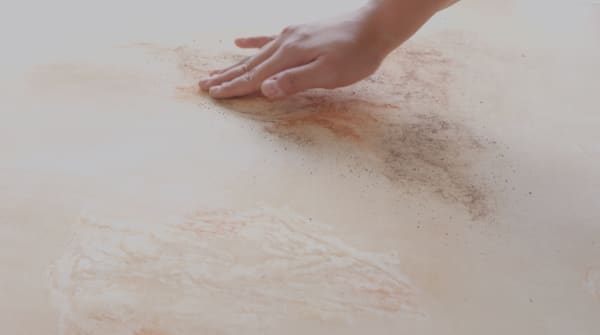Ashleigh Taupaki (Ngāti Hako)
Ashleigh Taupaki explores Māori connections to place through concepts of indigenous narrative and non-human agency. Working with carefully collected materials, she creates works that manifest ideas of kaitiakitanga (stewardship) and collaboration with natural resources. She depicts places that are significant to her own ancestral origins in Hauraki, and strives to revitalise the stories and knowledge of her people and lands.
On a recent 3-week research trip to Te Whanganui-a-Tara Wellington, Ashleigh explored the South coast (Te Moana o Raukawa) beaches collecting rocks, stones and fragments. She then ground these down forming earth pigments to use for painting three works on paper. By using local natural materials Ashleigh strengthened the connection with the local environment and the whakapapa of the land (whenua).
Ashleigh is currently studying towards a Doctor of Philosophy, specialising in Fine Arts. Her doctoral research looks into Ngāti Hako connections to wetlands, which also critiques colonial histories and occupations, while uplifting their mana as repositories of cultural knowledge and taonga species. Her research and residency trip was sponsored by Te Whare Hera and Enjoy Gallery.
Spending Time in Nature to Cure Depression [Corner]
I drove a City Hop car to Ōwhiro Bay. It was small, speedy, and took the winding turns of the Southern Coast with ease. The last time I was there, I was living in Te Whanganui-ā-Tara working for the Crown, thinking that as a graduate policy analyst asserting our kupu and knowledge in ministerial briefings and plans, I could somehow change the system incrementally, bit by bit. I called Wellington my depression corner because none of this happened. Every time I offered advice, it would be met with polite agreement, but then changed or redacted during the peer reviewing process. Systemic change was difficult. It was hard to even suggest that wairuatanga was something to consider when dealing with the environment — how can we begin to talk about the environment and her intricacies without considering how she holds and nurtures us in ways we cannot explain? We constantly talk about the healing properties of being outside, particularly in regard to mental health, so why can’t this be articulated into spirituality without it falling into this pagan-ritualistic-witchy territory? I soon resigned. I needed to heal and explore my own understanding of wairuatanga and the environment before coming back. I needed to touch the ground again, and see that my perceived depression corner was not Te Whanganui-ā-Tara, but rather the office space that belittled my experiences with a raised eyebrow and red-penned underlines.
As I walked the bay, I was met with pāua shells, and pumice the size of my head. Water rushed to the sea from the hills. In the middle of July, I took my socks and shoes off, feeling the water numb my toes as I looked for pretty coloured rocks. I collected them in a New World bag and thought about how this was the happiest I’ve ever felt in this city, taking time to myself to get away from thinking and writing and thinking about writing. There was no incentive to make a statement — just me and my rocks. During my walk, I came across fragments of a brick house. The reds of these bricks were brighter than the red rocks endemic to this beach, a duller, darker red of the land. I intended to stay on this one beach, but after this find — and perhaps also my fear of sea leopards during wintertime — I continued to drive the roads along Te Moana-ā-Raukawa. Off-coast islands littered different stones here and there. More colours to add to my kete. Shells and rock became less diverse the closer I came to the airport, and even the traces of early colonial settlements became null, thus ending my field trip.
I drove the car back to Te Papa where I had initially picked it up. The bag was heavy on my shoulder, and despite the short walk back to my residence at Te Whare Hēra, it felt like forever. The only thing stopping me from ordering an Uber back was the excitement of sorting the rocks by colour and feeling them in my hands one by one. Once back, the process of crushing via mortar and pestle began, a process that always involves loud oldie music and black coffee.
My hands shake after each rock is crushed into a powder, my palms red with shock, and fingertips stained with pigment. The powder colours are never the same as the stone. And as
I made these discoveries, watching the sea spray salt onto the gallery windows, I felt content.
Ashleigh Taupaki, August 2022






